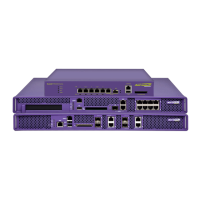Diagnostics
Summit WM3000 Series Controller System Reference Guide466
5 Refer to the Status field for the current state of the requests made from applet. This field displays
error messages if something goes wrong in the transaction between the applet and the controller.
6 Click the Refresh button to update the contents of the screen to the latest values.
7 Click the Close button to exit the screen. Clicking Close does not lose any data, as there are no values
configured within this screen (it is view-only).
Transferring Log Files
If a system log contains data that may require archiving, consider using the Transfer Files screen to
export the log file to an external location (that you designate) where there is no risk of deleting the
contents of the log.
To transfer a log file to a user specified location:
1 Select Diagnostics > System Logging from the main menu tree.
2 Select the File Mgt tab.
3 Select a target log file to transfer and click the Tran sfer File button.
4 Use the From drop-down menu (within the Source field) to specify the location from which the log
file is sent. If only the applet is available as a transfer location, use the default controller option.
5 Select a target file for transfer from the File drop-down menu. The drop-down menu contains the log
files listed within the File-Mgt screen.
6 Use the To drop-down menu (within the Target field) to define whether the target log file is to be
sent to the system's local disk (Local Disk) or to an external server (Server).
7 Provide the name of the file to be transferred within the File parameter. Ensure the file name is
correct or the transfer will not take place.
8 If Server has been selected as the source, use the Using drop down-menu to configure whether the
log file transfer is conducted using FTP or TFTP.
9 If Server has been selected as the source, enter the IP Address of the destination server or system
receiving the log file. Ensure the IP address is valid or risk jeopardizing the success of the log file
transfer.
10 If Server has been selected as the source, enter the User ID credentials required to send the log file to
the target location.
11 If Server has been selected as the source, use the Password parameter to enter the password required
to send the log file to the target location.
12 Specify the appropriate Path name to the target directory on the local system disk or server as
configured using the To parameter. If the local disk is selected, a browse button is available.
13 Click the Transfer button when ready to move the target file to the specified location. Repeat the
process as necessary to move each desired log file to the specified location.
14 If a problem condition is discovered during the file transfer, click the Abort button to terminate the
transfer.
Mnemonic
Use the
Mnemonic
as a text version of the severity code information. A
mnemonic is convention for the classification, organization, storage and
recollection of controller information.
Description
Displays a high-level overview of the event, and (when applicable)
message type, error or completion codes for further clarification of the
event. Use this information for troubleshooting or for data collection.

